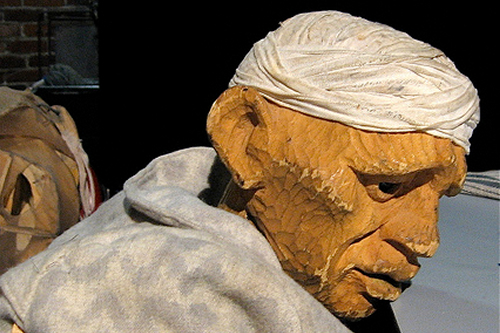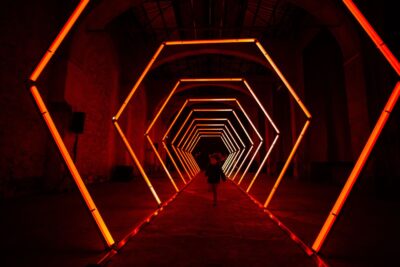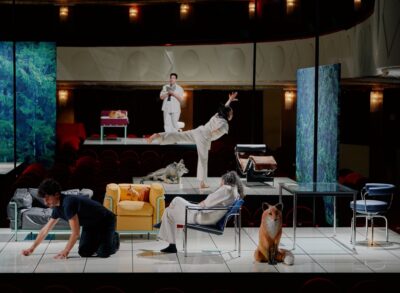Woyzeck on the Highveld An adaptation of German writer Georg Buchner’s famous play of jealousy, murder and the struggle of an ordinary man against an uncaring society which eventually destroys him. Büchner’s Woyzeck is a German soldier in 1800s, but in this version, Woyzeck is a migrant worker in 1950s Johannesburg, a landscape of barren industrialisation. The production brings together rod-manipulated puppets and animated film to graphically illustrate Woyzeck’s tortured mind as he tries to make sense of his external circumstances.
Creative Team
Production: Handspring Puppet Company with The Standard Bank National Arts Festival, the Johannesburg City Council, the Foundation for the Creative Arts, the German Embassy, the Department of National Education and Art Bureau (Munich).
Director: William Kentridge
Designers: Adrian Kohler and William Kentridge Animation: William Kentridge with assistant animator Erica Elk
Music by: Steve Cooks, Edward Jordan
Sound design: Wilbert Schoubel, Cello: Clara Hooyberg
Lighting design: Mannie Manim Cast Louis Seboko, Busi Zokufa, Busi Zokufa, Tale Motsepe, Basil Jones, Adrian Kohler Performances 1992-2011 South Africa, Germany, Belgium, Switzerland, UK, Canada, Spain, Sweden, USA, Australia, New Zealand, Israel, France, Italy, Poland and Spain. 2012 21 & 22 Sep 2012 Hopkins Centre for the Performing Arts, Dartmouth College, Hanover, New Hampshire, NA 27-29 Sep 2012 Museum of Contemporary Art Edlis Neeson Theater, Chicago, Il
Even William Kentridge works on Woyzeck as Robert Wilson had done in the Theatre (with music by Tom Waits) and William Herzog in the cinema with Klaus Kinski in 1979; the drama was written by Buchner in 1837 and was incomplete because of the death of the author, and so is a fragmented text, as it has been defined, in “stations”. It talks of the unhappy story of the soldier Franz Woyzeck, who dies humble jobs to support his companion Marie and their son who has not yet been baptised. To make more money he does everything for the captain and is a human guinea pig for a doctor for some experiments; Marie betrays him. Woyzeck finds Marie had his rival at a dance in a tavern, and madness and hallucinations bring him to kill the woman.
Kentridge had put on Buchner’s Woyzeck in 1992; in the program notes of the show Kentridge wrote that he was close to this drama as he had seen it as an emblem of conflict (social, political and emotional) after a show in the 70’s and since then he tired to imagine a different context from that of Prussia of the 19th century.
The new context could be none other than the South Africa of today. The second aspect that pushed him to the representation was the desire to work with the company Handspring Puppet Company in a mixed performance where the drawing could be united with the general frame of the representation where the actors were taken away and replaced by puppets where other ways to transmit the emotional depth where not guided by the face of the actor. The third reason was the desire to put an animated film onto the stage that would have a dynamic rapport with the movement of the puppets on stage and that would update the ancient culture of the theatre of figures and the shadow theatre.
Today’s work seen at the Eliseo Theatre during the Romaeuropa festival kept an extraordinary force thanks to the presence of the wooden puppets of human proportions that were guided efficiently by stagehands that were not wearing hoods that awaken an ancient curiosity, and the able animated work of Kentridge
This takes us, without words, into Woyzeck’s head, exploited, overwhelmed, offended, persecuted by the powerful and betrayed, he who thinks differently, who is the emblem of the persecuted and the humble ill-treated man who at the end succumbs to his own nightmares, goes mad and kills the woman he loves as a definitive act of self annihilation and rebellion. Woyzeck’s mind races between objects, processions of shadows and desires that are not expressed, dreams, psychological disturbances, and enchanting wonders. The sky is a forest of stars and is the only ray of light in an impossible happiness. The technique Kentridge uses is extraordinary as is that of the stagehands of the puppets: in both cases the hand that gives the soul tot eh object. The spectator can be considered the sum of the artistic work of William Kentridge, also because of the theme that is dealt with, that has the South African Apartheid as its foundation. (ANNA MARIA MONTEVERDI)





